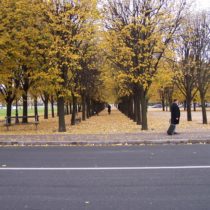Landscape Architecture for Landscape Architects › Forums › PLACES & SPACES › beyond new urbanism
- This topic has 1 reply, 7 voices, and was last updated 15 years, 2 months ago by
 nca.
nca.
-
AuthorPosts
-
May 25, 2010 at 9:35 pm #169486
 Roland BeinertParticipant
Roland BeinertParticipantI found this article about Andres Duany and what he sees as the future of the new urbanist movement: http://www.treehugger.com/files/2010/05/new-urbanism-evolves-future-is-agrarian-urbanism.php
I suppose it’s not a completely new idea, but I wonder what this will mean for landscape architects if new urbanists decide to follow Duany on this. Up to now the new urbanists have focused on the basic structure and layout of towns and neighborhoods. With agrarian urbanism, the relationship of the town or neighborhood to the land becomes a larger part of the focus.
May 25, 2010 at 10:05 pm #169505 ncaParticipant
ncaParticipantIt still looks and sounds like New Urbanism and an extension of Duany’s transect idea from the suburban to the rural fringe. I feel like this is what wwe’ve been trying to do all along.
In some of the latest projects I’ve been able to work on here we’ve explored the idea of ‘agriburbia’ which is basically using rural land for farming within the same typical suburban subdivision. It’s a marketing ploy in my opinion–when a developer cant afford to develop a certain piece of their property of the market cant absorb more housing they can farm it and call it sustainable. It’s still the same sprawling pattern.
Another conclusion we came to here is that people in true suburban communities dont typically like to live next to real farms unless the associated development accomodates for that function, ie the rural/low density pattern. That said, I think there is a huge opportunity for a suburban agricultural pattern that fosters community and commerce without becoming compktely rural.
What I’ve found in my very limited experience to be one of the greatest difficulties in master planning is learning the most equitable way to make transitions between uses without doing sprawl and without sacrificing some of the good things that go into making a good neighborhood. Duany’s transects try to adress this with a formula which I think works well for its intended use in form based code for municipalities.
The CNU site has some good examples in their case studies section on real projects that attempt to create new patterns and transitional edges.
To me, this is what I thought ‘Landscape Urbanism’ was supposed to be all about, sort of, but I think the message has become so convoluted whereas Duany and some of the NU’ists tend to just do stuff and draw pictures and diagrams to state exactly what they’re talking about. I like that. I like how Duany refers to the ‘project’ that is the United States, very true imo.
Kunstler repeats himself with the same talking points, though entertaining.
May 26, 2010 at 4:29 pm #169504 ncaParticipant
ncaParticipantGood topic Roland.
Unfortunately it seems there isn’t much interest in urbanism discussion.
May 26, 2010 at 5:10 pm #169503 Steve_WhiteParticipant
Steve_WhiteParticipant“He points out that the New Urbanists were fiercely opposed and often mocked as “being slaves to worn-out traditions — like walking from home to work.””
this is just funny. a bunch of white collars standing in a room making fun of the guy who wants to “walk home from work”
May 26, 2010 at 9:54 pm #169502 Jason T. RadiceParticipant
Jason T. RadiceParticipantI just don’t think there is much interest in what Duany has to say anymore. He was relevant 20 years ago. He’s just another architect like Wright, Le Corbusier, Gehry, and multitudes of others who thinks he knows the best way to design for the unwashed masses.
I think most people interested in urbanism (including me) have written him off as an ideologue or a utopian whose physical manifestations of his theories do not live up to the hype. I even think the “smart growth” movement is coming to an end; it’s all counterintuitive to human wants and needs as well as market forces. Not to mention the sovereignty of local community planning agencies and the private property rights of the citizenry, especially when the political climate is tending now towards the opinion of overregulation.
May 26, 2010 at 11:15 pm #169501 Bob LutherParticipant
Bob LutherParticipantIt is not that new urbanism or agrourbanism or agriburbia are bad ideas, it is more the fact that those concepts work for the people that want them. The general public (rightly or wrongly) has a vision of what they want and that is what they are going to buy. Most new urbanism works in the vacuum of philosophy but fails in actual practice, the success would be in creating of utopic communes where people can live this life style by choice. I would love to live were I work, I love the idea of live work spaces and transit oriented districts, mass transit can be a good thing too but if you are not in control of your place of business (the boss) you are stuck with where you go to work, you have a choice as to where to live but work spaces are often either in flashy high rent areas or in an industrial park on the wrong side of town, putting these items all into one basket is the tough part. the concepts of the article are nice but they will not happen without a major shift in our cultural visions.
May 26, 2010 at 11:37 pm #169500 Roland BeinertParticipant
Roland BeinertParticipantOne thing I’ve noticed is that critics of smart growth don’t really make any effort to understand it. They love to characterize it as “utopian” without realizing how much utopian thinking went into the sprawling development we see today. Go back a few decades and you see the architects you compared Duany to (especially Corb) talking about a glorious new age of prosperity where everyone lives in towers in shining cities and drives around in cars. Smart growth is largely a criticism of that utopian thinking. It is based on development patterns that have been around for thousands of years, but is percieved as new because sprawl has been the norm for the past few decades.
May 26, 2010 at 11:49 pm #169499 Bob LutherParticipant
Bob LutherParticipantSprawl is the dream… the wife and 2.5 kids in a house in the burbs with a dog, a cat, and a white picket fence. How do you change the dream?
May 27, 2010 at 12:00 am #169498 Trace OneParticipant
Trace OneParticipantsprawl is not my dream, by any means..I personally do not understand the attraction..I spent some of my formative years in McLean Virginia, and god, what a high-priced, non-transit oriented hell-hole..I think that is why I am an LA..What is good about the burbs? I love the mix, love walkability, and have created it in Fresno for myself, and found the natives who believe like me..
since when is Duany dead? I beg to differ..We spent a lot of time in Charlottesville creating the mixed use downtown,and it works..
I think people who locate their 2.5 kids in the burbs are absolutely crazy..the burbs are like eucalyptus – they are biotic wastelands..Atlanta is the WORST..I do not believe that people are not convinced..Just charge 10$ for gas, and people will get the point pretty quick..May 27, 2010 at 12:29 am #169497 Roland BeinertParticipant
Roland BeinertParticipantI think ultimately people need to realize that sprawl doesn’t really fit all people’s needs, and then the American dream will start to change and include other living situations. There is nothing wrong with wanting a single family house or with living in the country. The problem is that people are convinced by real estate agents and others that that is all they SHOULD want, even though many people live in circumstances where they might be happier living in something else. The market reflects this distorted view, and so now the only choices we have are single family housing in the suburbs or cheaply built aprtments with little in between for entry level buyers or people who need to live where they work. We often no longer even have the option of live/work or granny flats or whatever, and that reinforces the idea that we should live in single family housing.
I think form based codes and other things new urbanists propose really can change this situation. Despite claims that new urbanism stifles freedom of choice, form based codes actually allow people to work where they live or live near their work without having to get permission from the local government. People need to be educated about that sort of thing. Their understanding of development needs to catch up with what architects, planners and LA’s are discussing in forums like this one. Once it does, they may very well demand that sort of thing.
There’s a town in northern Idaho, Priest River, that is a good example. People living along the highway often have businesses and residences on the same property. It’s something they want. But they need permits to do it. Form based codes would allow them to use their properties as they want as long as the building form fits in with the surrounding development. But the city council is a little wary of the idea, because it is perceived as something new.May 27, 2010 at 12:59 am #169496 ncaParticipant
ncaParticipant“Sprawl is the dream… the wife and 2.5 kids in a house in the burbs with a dog, a cat, and a white picket fence. How do you change the dream?’
The ‘(American) Dream’ hasn’t necessarily changed, we’ve just figured out how to market a cheaper version of it.
May 27, 2010 at 1:00 am #169495 ncaParticipant
ncaParticipantCouldnt have said it better myself Roland.
May 27, 2010 at 1:11 am #169494 ncaParticipant
ncaParticipantI agree.
I’m too tired to analyze this, but I dont see where people are getting the idea that NU doesnt work. That said, I dont agree that there is a single formula for good community design as I still believe strongly in site-based design.
I personally dont see the attraction some have to sprawl suburbs–we all know the places–40 foot streets, cul de sacs all over the place, aimless roads, garage houses, and lawn leftovers masquerading as public space.
May 27, 2010 at 5:15 am #169493 BoilerplaterParticipant
BoilerplaterParticipantHey don’t bail too quickly! I’m down with it! Just had court today for…never mind, don’t wanna talk about it.
I’m thinking some golf courses will be abandoned to agricultural uses. Like he says, people want the open space. yet they can’t make it as golf courses. Why not convert to agrigultural use and the at least a small profit can be realized and the neighbors still get their open space.
May 27, 2010 at 6:53 am #169492 Jason T. RadiceParticipant
Jason T. RadiceParticipantMany of the concepts are sound, but in practice, they are essentially just fancy suburbs. Not transit oriented, not walk to work (for a vast majority of residents), and usually with a density that makes them uncomfortable to maximize profit. They CONTRIBUTE to sprawl. And holy crap are they expensive. Most are built on greenfield sites well out of developed areas. And you still have to drive to get most places. part of the issue is zoning, which allows for only certain building types with certain densities. And the architecture leaves a lot to be desired.
If you really want to be new urbanist, you really should be OLD urbanist. Reclaim buildings, neighborhoods, even whole towns. If you must build new, infill. Build where the infrastructure is already there. Where neighborhoods actually have character, and close to where people actually work. Gentrification is not a bad thing.
-
AuthorPosts
- You must be logged in to reply to this topic.


